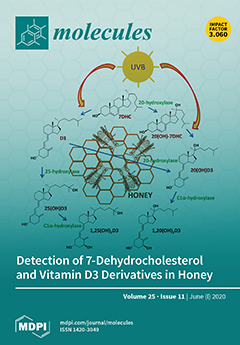The air-dried aerial parts of
Phlomis russeliana (Sims) Lag. Ex Benth. was extracted by methanol and fractionated by
n-hexane, dichloromethane, and ethyl acetate, respectively. The wound healing properties of
P. russeliana extract gel was evaluated using the in vivo excisional wound model
[...] Read more.
The air-dried aerial parts of
Phlomis russeliana (Sims) Lag. Ex Benth. was extracted by methanol and fractionated by
n-hexane, dichloromethane, and ethyl acetate, respectively. The wound healing properties of
P. russeliana extract gel was evaluated using the in vivo excisional wound model using Balb-c mice. Initially, the
P. russeliana methanol extract showed LOX inhibitory activity at IC
50 = 23.2 µg/mL, whereas the DPPH
• assay showed IC
50 = 0.89 mg/mL, and the ABTS
• assay showed IC
50 = 0.99 mg/mL, respectively. In addition, a remarkable anti-inflammatory activity was observed in the cell culture assay. Thereafter, activity-guided fractionation was performed by LOX enzyme inhibition assays, and the structures of the two most active fractions were revealed by both GC–FID and GC/MS analyses, simultaneously. Phytol and 1-heptadecanoic acid were characterized as the active constituents. Moreover, the
P. russeliana extract gel formulation was applied for in vivo tests, where the new gel formulation supported the in vitro anti-inflammatory activity findings. As a conclusion, this experimental results support the wound healing evidence based on the ethnobotanical application of
Phlomis species with further potential.
Full article






